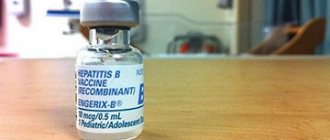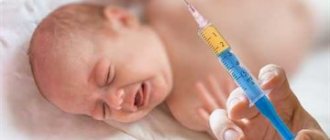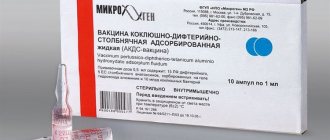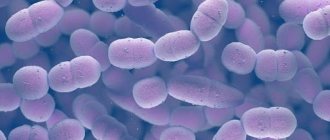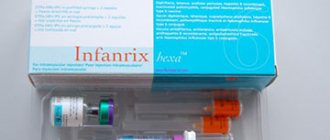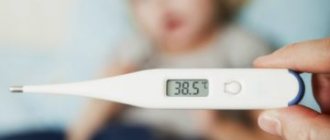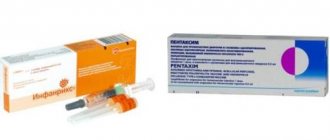DTP vaccines
DTP (international abbreviation DTP) is a combined vaccine against diphtheria, tetanus and whooping cough.
Adverse reactions: DTP vaccines (DTP, Tetrakok) are among the most reactogenic vaccines . And this is not surprising, given the high dosages of antigens included in their composition and their nature. The most reactogenic component of DTP should be considered inactivated pertussis bacillus. The fact is that its antigens tend to infect brain tissue directly and through the forces of the immune system (since these same antigens have some similarities with the antigens of the meninges). This occurs with whooping cough itself (which is the cause of the characteristic spasmodic cough and convulsions during infection) and (to a much lesser extent, since the antigens in the vaccine are different from “natural”) during vaccination.
Local reactions: Caused mainly by the presence of aluminum hydroxide in vaccines, which is necessary to enhance immunity to toxoids, and a high dosage of antigens. All reactions appear more often after repeated administrations of DTP. Most often, there is induration (1.3%), redness of more than 2 cm (1%), sometimes quite significant pain at the injection site (up to 19%), which is expressed in the fact that the child is “protecting” the leg. Severe local reactions include redness more than 8 cm in diameter.
The most common symptoms are induration (1.3%), redness more than 2 cm (1%)
General reactions: Like local reactions, they occur somewhat more often after repeated administration of vaccines. There is an increase in body temperature up to 38oC (up to 40% of cases), over 39oC (1%). Prophylactic administration of antipyretics 2-3 hours and the next day after vaccination is highly recommended, which minimizes the risk of fever and some local reactions.
Severe reactions: These include a child’s prolonged piercing crying (constant persistent crying) - unusual (even squealing) crying of a child, usually continuing continuously for 3 hours. The frequency of such a reaction is estimated to be 1 in 200 cases. The cause is supposed to be a headache, and pain at the injection site, and since the child cannot complain, he simply cries. Despite the fact that this reaction frightens parents who are not mentally prepared and are not informed about this possibility, it passes without consequences. It must be said that the same reaction also occurs with whooping cough in combination with other symptoms.
Comparison of the frequency of complications during DPT vaccination and whooping cough (Ozeretskovsky N.A., 1998, based on WHO materials)
| Nature of complications | Frequency of whooping cough (per 100 thousand cases) | Frequency of DTP vaccination per 100 thousand vaccinated |
| Persistent brain damage | 600-2000 | 0,2-0,6 |
| Encephalopathy and encephalitis (transient neurological symptoms and seizures) | 90-4000 | 0,1-3,0 |
| Convulsions | 600-8000 | 0,3-90 |
| Shock | ? | 0,5-30 |
| Death | 100-4000 | 0,2 |
Comparisons of the incidence of reactions and complications between infection and vaccine are not 100% correct, since vaccines are used in (relatively) healthy children and ideally should not cause reactions. However, from a practical point of view, whooping cough is the most widespread in the CIS, so this comparison probably makes sense to be regarded as a “payment” for vaccination in comparison with the “payment” of the body in case of infection. Currently, pertussis vaccines have been developed that cause fewer adverse reactions (so-called “acellular” vaccines), but they are not imported into Russia due to their high cost.
Complications: As with the administration of any other vaccine, anaphylactic shock is observed in rare cases; convulsions without fever (afebrile convulsions), encephalopathy (convulsions + short-term impairment of consciousness), a possible connection between DPT vaccination and encephalitis (1 per 250-500 thousand vaccinations), but this connection has not been conclusively proven.
Motive for vaccination
Why, despite the possible development of side effects, do people agree to get vaccinated against coronavirus? Firstly, the number of people sick and dying from a dangerous infection is constantly growing. As one of the respondents noted, during the first wave, not everyone had an acquaintance who became infected with the coronavirus. This fall, everyone has such a friend. Not wanting to become part of the nasty statistics, people agree to lie down for a day or two with a fever and muscle pain, rather than later have complications in the form of pneumonia and lung damage, which can lead to death.
Secondly, many have elderly parents and grandparents who are at risk. Their safety must be taken care of above all. Many people get vaccinated, hoping not to get sick and not infect their loved ones.
Thirdly, the majority have a positive attitude towards vaccinations. Often those who are against vaccination simply do not have the necessary medical knowledge. For example, if an immune layer is created in society, then the coronavirus will cease to be so terrible, and the pandemic will end. There are several similar examples over the last century when a vaccine saved humanity from a dangerous disease. However, people who are against vaccinations do not want to admit this and change their minds.
OPV (live oral polio vaccine)
OPV (live oral polio vaccine) - oral polio vaccine types 1,2,3
Poliomyelitis (from the ancient Greek πολιός - gray and µυελός - spinal cord) is infantile spinal paralysis, an acute, highly contagious infectious disease caused by damage to the gray matter (consists mainly of the bodies of nerve cells with their processes that do not have a myelin sheath) of the spinal cord poliovirus and is characterized primarily by pathology of the nervous system. Mostly occurs in an asymptomatic or erased form.
In principle, the vaccine consists of three types of live, attenuated polioviruses. It is administered orally, in the form of drops on a piece of sugar, bread or in syrup. It is one of the least reactogenic vaccines.
Local complications: Since the vaccine is administered orally, local complications should be considered to be those that occur in the intestines. Rare complications of OPV include intestinal dysfunction (the connection with vaccination is quite controversial, since intestinal dysfunction is observed in young children even without vaccinations) - it does not require treatment and goes away on its own within a few days. OPV is not a contraindication to further vaccinations.
General complications: Allergic reactions detected within 4 days after vaccination. The connection to vaccination is also controversial if the child has not been tested for food allergies. It is also not a contraindication to further vaccinations. The exception is cases of allergy to the antibiotic kanamycin , which is contained in domestic vaccines.
Allergic reactions detected within 4 days after vaccination
Vaccine-associated paralytic polio (VAPP): A recognized and proven complication of OPV vaccination, reported with a frequency of 1 in 1-3 million vaccinations, more often with the first vaccination than with repeat vaccinations (1 in 6-12 million vaccinations). Since a vaccinated child releases viruses into the environment, some VAPP occurs in contacts of unvaccinated individuals (1 in 14 million vaccinations). WHO defines the criteria for VAPP as the appearance 4-30 days after vaccination (60 days for contacts), the presence of residual manifestations of paralysis after 2 months. from the onset of the disease, the release of the vaccine virus from the patient, the increase in antibodies in the blood by 4 times. For prevention, it is recommended to use inactivated polio vaccine (IPV) for the first two or all vaccinations.
IPV (Strengthened Inactivated Polio Vaccine)
IPV (strengthened inactivated polio vaccine), Imovax Polio
Unlike a live vaccine, an inactivated vaccine is administered by injection. It does not contain live viruses and is therefore safe even for children with impaired immune systems and those infected with HIV. Does not cause VAPP.
Local reactions. There are no specific reactions. The usual local reactions are noted - redness, thickening, soreness. Frequency – about 5%.
seal
General reactions: There are no specific reactions. Increased body temperature to 38°C, malaise, weakness. They are quite rare, non-specific, the frequency does not exceed the levels traditional for inactivated vaccines - 2%.
Complications: Due to the fact that antibiotics (neomycin, streptomycin) are used in the production of vaccines to prevent microbial contamination, trace amounts are found in vaccines. In this regard, in persons with a documented allergy to specific antibiotics, the administration of vaccines (despite contraindications) without taking the necessary precautions can lead to allergic disorders.
Measles, Ruvax, etc.
All measles vaccines contain live, attenuated measles viruses. In practice, reactions associated with the reproduction and presence of live viruses in the body may occur. However, measles vaccine is one of the least reactogenic.
Local reactions: There are no specific reactions.
General reactions: They usually occur 5-15 days after vaccination (this time is required for the reproduction and spread of viruses in the body). After this period, with a probability of 5-15%, an increase in body temperature, a rash lasting 2-3 days (5%) (resembling measles), painless transient enlargement of the lymph nodes, runny nose, and cough may be observed. If a complex of such symptoms is observed, then this condition is called “vaccinated measles.”
Complications: Allergic reactions - components of vaccines that can cause exacerbation of allergies are trace amounts of antibiotics (kanamycin, neomycin), trace amounts of ballast proteins of bird eggs (quail - in the Russian vaccine, chicken - in imported ones). Convulsions against the background of an increase in temperature are not a reaction specific to the measles vaccine - they can occur after the administration of any other vaccine if the adverse reaction is an increase in body temperature above 39 ° C. Persistent damage to the central nervous system (encephalitis) occurs with a frequency of 1 in 1 million vaccinations, however, given that encephalitis generally occurs with greater frequency among unvaccinated people (dozens of other viruses can be the cause), this is unlikely to be such a typical complication of the measles vaccine. A more typical complication is the so-called. subacute sclerosing panencephalitis (less than 1 in 1 million vaccinations), which with measles itself is observed with a frequency of 1 in 2000 cases (!). Against the background of a vaccine reaction, pneumonia may develop (1:20 cases with measles itself!). Pneumonia is secondary, that is, caused not by vaccine viruses, but by bacteria from the upper respiratory tract. A temporary decrease in the number of platelets in the blood is benign, that is, it does not lead to any consequences and in most cases passes unnoticed, without symptoms. If the course of thrombocytopenia is obvious, then a temporary increase in bleeding may be observed - a slight prolongation of blood clotting time, which in turn may manifest itself as a pinpoint rash on the bends of the limbs. Abdominal pain (abdominal syndrome) is quite rare and has no clear connection with the vaccine. It is believed that the reason for this is a temporary enlargement of the intestinal lymph nodes in response to the multiplication of the vaccine virus. In such cases, you should not neglect consulting a surgeon to rule out other abdominal diseases (appendicitis, cholecystitis).
Mild side effects after vaccination
Although in most cases the side effects of the Covid-19 vaccine, according to its creators, are not alarming, we should not forget about the individual sensitivity of each organism. A person can react with mild or serious irritation to even the most harmless medications.
Among the mild side effects that may develop after the administration of drugs against coronavirus infection, experts include:
- headaches (if there are problems with the cardiovascular system, they may be accompanied by dizziness);
- temperature fluctuations (they do not cause any particular concern - the temperature rarely rises to 37.5 degrees);
- attacks of nausea (this symptom is noted in people with unstable functioning of the digestive tract, metabolic disorders or diseases of the stomach and intestines);
- increased heart rate or irregular heart rhythm;
- irritation on the skin (rashes most often appear on sensitive areas of the body - back, chest, face, but can also be localized at the site of drug administration);
- upset stool (this sign of irritation appears against the background of diseases of the digestive tract).
In the first days after administration of the drug, fatigue may appear, which can disturb you even after a long rest or full sleep. Unpleasant discomfort goes away quickly - usually a walk in the fresh air is enough for this.
Mumps (not registered in Russia)
Like the measles vaccine, the mumps vaccine also contains live, weakened mumps viruses.
Mumps (synonyms: mumps, mumps) is an inflammation of the parotid gland. The most common is mumps, which is caused by a special virus. There is also non-epidemic mumps, which can be caused by injury, hypothermia (for example, even if you wet your feet in cold water), or infection in a wound in the oral cavity.
Local reactions: There are no specific reactions.
General reactions: Similar to reactions to measles vaccine. Usually observed on days 4-12. As with mumps, swelling of the salivary glands is possible, but with incomparably less frequency and intensity.
Complications: In general, the spectrum and frequency of those for measles vaccine are repeated. A complication characteristic of the mumps vaccine is short-term swelling of the testicles in boys, which passes without consequences (unlike natural mumps); serous meningoencephalitis (frequency with mumps itself is 1 in 300 cases), which appears on days 5-30 and goes away after a few days without any consequences.
Rubella
The vaccine complements the class of live viral vaccines, which are prepared from weakened viruses.
Rubella (lat. rubella
) or
the third disease
is an epidemic viral disease with an incubation period of about 15-24 days. It is usually a harmless disease that mainly affects children, but it can cause serious birth defects if a woman becomes infected early in pregnancy.
Local reactions: There are no specific reactions.
General reactions: A slight increase in body temperature, malaise, enlarged lymph nodes (especially the occipital and posterior cervical), swelling in the joints (caused by benign transient inflammation of the tissues of the joints, most often the knee and wrist) are observed in 2% of adolescents, 6% of children, 20% of adults. In this case, most reactions are represented by an increase in body temperature. Arthritis is quite rare. A rash is reported in 5% of vaccinated people.
Complications: The vaccine is absolutely contraindicated for use during pregnancy, regardless of its duration.
However, if this does happen (the woman did not know that she was pregnant at the time of vaccination), it is not recommended to terminate the pregnancy. A rare complication is a temporary decrease in the number of platelets in the blood - the same as with measles vaccine. Occurs 2-3 weeks after vaccination. Allergic reactions can be caused by the presence of trace amounts of antibiotics (kanamycin, neomycin) in the vaccine.
Opinion of an academician of the Russian Academy of Sciences on vaccination
Vitaly Zverev, an academician of the Russian Academy of Sciences and an outstanding Russian virologist, in his interview with the Public News Service said that he would not be vaccinated against coronavirus infection and explained his position on this matter. In his opinion, at the moment there is no completely accurate data that the vaccine is effective and safe. The academician also noted that until the duration of immunity has been determined, it would be wrong to encourage people to get vaccinated.
According to the virologist, it will be possible to talk seriously about coronavirus vaccinations only in a few years. If the ongoing vaccine trials are successful, then it will be possible to expect a finished vaccine at the end of this year. However, it is possible that the dates may move to a later time.
Vitaly Zverev noted that the infection has shown itself to be not very scary, with a low mortality rate, which means that the creation of a vaccine is more of a political nature and is not very related to the fight against the virus itself. In addition, Western experts previously stated that the race to create an effective vaccine could become more dangerous than the disease itself.
Hepatitis B
All modern vaccines for the prevention of viral hepatitis B are prepared using genetic engineering technology. A segment of the virus genome is introduced into the genetic material of baker's yeast, which is responsible for the production of the “Australian” (HBsAg) antigen. Vaccines practically consist of 90-95% antigen, 5-10% of other components, the most significant of which is aluminum hydroxide.
Local reactions: Caused by the presence of aluminum hydroxide in the vaccine, which is intended to enhance the local reaction and, as a result, the immune response to the vaccine. In general, up to 15% of vaccinated people experience thickening, redness, and soreness. The reactions are mild, do not require treatment and resolve on their own within 1-2 days.
redness
General reactions: There are no specific reactions.
Complications: Common complications that can occur with any other vaccination are anaphylactic shock, urticaria (1 in 100 thousand vaccinations), allergic rash (1 in 30,000 vaccinations). In persons with a food allergy to yeast dough (bread), it may worsen. Until recently, discussions continued about the connection between hepatitis B vaccinations and multiple sclerosis. The final WHO statement on this issue states that there is no evidence of such a connection (!), since none of the studies conducted under the auspices of WHO found an increased frequency of reactions - the frequency of multiple sclerosis among vaccinated people did not exceed normal levels (1 per 300 thousand adults and 1 million children). The source of concern about multiple sclerosis was the flawed assumption that the observed increase in the relative incidence of multiple sclerosis among those vaccinated was simply due to an increase in the number of vaccinations in developed countries.
Haemophilus influenzae infection
Modern vaccines are chemically linked antigens of the Haemophilus influenzae capsule and tetanus toxoid, which is necessary for the main antigen to produce immunity in children under 18 months of age.
Haemophilus influenzae infection is an acute infectious disease caused by Haemophilus influenzae. Hemophilus influenzae infection is characterized by predominant damage to the respiratory system, central nervous system and the development of purulent foci in various organs.
The causative agent is Haemophilus influenzae (Pfeiffer bacillus) belongs to the family Pasteurellaceae
, genus Hemophilus
Haemophilus influenzae colonies on blood agar
Haemophilus influenzae infection can occur in the following clinical forms:
- Purulent meningitis.
- Acute pneumonia.
- Septicemia.
- Inflammation of the subcutaneous tissue (cellulite).
- Epiglottitis (inflammation of the epiglottis).
- Purulent arthritis.
- Other diseases (pericarditis, sinusitis, otitis, respiratory tract diseases, etc.).
Local reactions: In 9% (maximum) of cases, usual local adverse reactions may occur - swelling, soreness, redness. A slightly higher frequency of reactions is caused both by the polysaccharide antigen itself and by tetanus toxoid, which does not form immunity, but can cause reactions and complications.
redness
General reactions: Uncharacteristic and nonspecific. The frequency does not exceed 1%.
Complications: There are no specific complications, but they are possible in persons allergic to tetanus toxoid.
Currently, the question of whether there is a connection between vaccination against Haemophilus influenzae and type 1 diabetes mellitus (congenital diabetes) is being actively discussed. Concerns, as in the case of vaccines against hepatitis B, are caused by an understandable increase in the number of registered diabetes in vaccinated people against the backdrop of an increase in the number of people vaccinated against Hib infection. There is no other evidence linking vaccinations and diabetes, and the likelihood that such a cause-and-effect relationship will be established is minimal. In none of the countries where vaccinations against Hib infection are carried out, vaccination has been stopped or cancelled.
Ended up in intensive care: what happened to the doctor after vaccination
After receiving an injection of the Pfizer/BioNTech vaccine approved by the World Health Organization, the deputy head of a hospital in the suburbs of Athens ended up in intensive care. According to one of the local TV channels, the man who ended up in intensive care is now undergoing intubation treatment at the Nikaya State Hospital.
The man who was vaccinated did not have coronavirus, but after receiving the vaccine he developed symptoms of lower respiratory tract disease. A coronavirus test was done and it gave a negative result. However, over time, the man’s condition worsened and the doctors considered it necessary to perform intubation because a diagnosis of “respiratory failure due to lower respiratory tract infection” was made.
